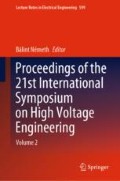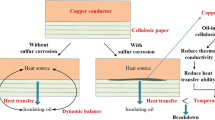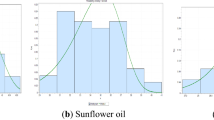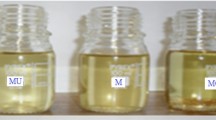Abstract
Solid state transformers (SSTs) are a new type of transformers where power electronics and conventional transforming elements are combined into one. The basic principle is that the voltage gets converted into the kHz range before it is transformed to another voltage level. The main advantage of this technology is the size of the transformer - due to the used higher frequency the transformer core and thus the whole apparatus can be built smaller than traditional 50/60 Hz power transformers. Currently there are no oil impregnated cellulosic insulation systems available for high-voltage high-frequency applications. This is partly because the exact breakdown mechanism at high frequency (HF) stress is still unclear and partly because long-term behavior of cellulosic insulation systems under HF-stress is unknown. The main goal of this publication is to provide new experiments and data to contribute on the research of the HF breakdown mechanism in oil impregnated cellulosic insulation systems. For this purpose breakdown experiments on oil impregnated paper samples were conducted at frequencies of 50 Hz, 20 kHz and 40 kHz with unipolar voltage pulses. Tests were performed at 20 ℃ and 90 ℃ in synthetic ester fluid Midel 7131. As voltage source a special self-developed pulsed HF generator was used that provides high-voltage high-frequency voltage up to 6.5 kV between 50 Hz and 40 kHz.
As expected, decrease in breakdown voltage with increasing frequency could be shown. But more important, the findings presented in this paper surprisingly also suggest that contrary to most literature not heating due to increased polarization losses is the main responsible breakdown mechanism at high frequency stress.
Similar content being viewed by others
Keywords
- High voltage high frequency breakdown
- Breakdown mechanism at high frequency
- Oil paper insulation
- Solid state transformer
1 Introduction
Solid state transformers (SSTs) are a type of transformer where power electronics and a conventional transforming element are combined [1]. The function of this device is to convert the signal into the kHz range before it is transformed to another voltage level with the transformer. After the transformation the frequency is again adjusted to 50 Hz for example. Of course, any other voltage form and frequency can be realized after the voltage transformation with power electronics. The main advantage of this technology is that due to the higher frequency the transformer core and thus the apparatus can be built quite small compared to standard 50/60 Hz transformers. So, comparing with conventional transformers, SSTs can achieve higher power density while at the same time offering additional features like reactive power compensation, voltage regulation, fault isolation and DC link. This makes SSTs very attractive in smart grid, traction drive and renewable energy systems applications. Therefore, their application is expected to become increasingly relevant in power systems in the coming years.
The transforming element in SST applications, where a high amount of power is needed, will still be the traditional power transformer with the traditional oil impregnated cellulosic insulation. This is because of the excellent cooling capability of the oil. That means, of course, that the oil/paper insulation system has to be investigated regarding its behaviour under high-frequency stress. Furthermore, apart from cooling, other main challenges in the design of these transformers are dielectric insulation requirements due to the large dv/dt of the voltage, high magnetizing and leakage inductances, minimal inter and intra winding capacitances and optimum size. In [2] a process is described for design optimization, considering all abovementioned requirements. Notwithstanding these many issues oil/paper insulated transformers still are offering important advantages in comparison with dry type or water-cooled solutions.
Until today there are no oil impregnated cellulosic insulation systems for high voltage high frequency stress available at the market. This is mainly due to the fact that the exact breakdown mechanism at high frequency (HF) stress is still unknown and also data of long-term behaviour of cellulosic insulation systems under HF-stress is missing. Only with this missing information suitable oil impregnated cellulosic insulation systems for SST applications will be possible in the future.
The main goal of this publication is to provide new experiments and data to contribute on the research of the HF breakdown mechanism in oil impregnated cellulosic insulation systems. For this purpose breakdown experiments on impregnated paper samples were conducted at frequencies of 50 Hz, 20 kHz and 40 kHz with unipolar voltage pulses. All tests were performed at 20 ℃ and 90 ℃ in synthetic ester fluid Midel 7131. As voltage source a special self-developed pulsed HF generator was used that provides high-voltage high-frequency voltage up to 6.5 kV between 50 Hz and 40 kHz.
The findings in this measurement study strongly suggest that contrary to most literature not heating due to increased polarization losses is the main responsible breakdown mechanism at HF stress.
2 Theory
The exact breakdown mechanism of insulation systems at high frequency (HF) voltage is still unclear. In literature two possible approaches are used by the majority of the researchers for explaining the effect of decreasing breakdown voltage with increasing frequency of the voltage.
First explanation is that increased voltage frequency leads to increased polarization losses due to the constant reorientation of dipoles in the insulation as they try to follow the outer field direction. These increased polarization losses result in thermal heating of the insulation which eventually lead to a thermal breakdown of the insulation [3,4,5]. Some authors report an increase in PD activity and lower PD inception voltage at higher frequency stress. This is also explained with the increased polarization losses and followed by increased heating of the insulation favoring a heat breakdown [3, 10].
The second explanation puts accent more on the statistics of the increased frequency for short time breakdown than on the dielectric losses. At 50 Hz the insulation is exposed to 100 voltage peaks (50 negative and 50 positive) and 100 zero crossings per second. At 40 kHz the insulation system is exposed to 80’000 voltage peaks and zero crossings per second. This stress leads to a weaker short time breakdown performance at increased frequencies [6].
2.1 Effects Influencing the Dielectric Strength
Various well known factors affect the dielectric strength of oil impregnated cellulosic insulation system, e.g., water content, temperature etc.
The temperature of the oil causes a decrease in breakdown voltage during a standard IEC 156 test, from 80 kV to 70 kV when varied between 20 ℃ and 90 ℃ - which is a decrease of 12.5% [7].
3 Methods
3.1 Pulsed HF Source
As there was no commercial voltage source available that could supply high voltage signals in the required frequency range a new voltage source had to be developed [8]. The developed pulsed high frequency (HF) voltage source is capable of delivering signals present in SST applications. It can deliver up to 6.5 kV at a frequency from 50 Hz to 40 kHz. The voltage shape is of pulsed shape and no continuous sine wave. An example of a 40 kHz voltage signal can be seen in Fig. 1.
Basically, the pulsed HF source is a half bridge built with two powerful SiC-MOSFETs and some control logic. The rise time depends very much on the inductance of the test object In the given arrangement, a rise time of about 100 kV/µs is possible. As the pulsed HF source can only generate a voltage peak of 1.7 kV due to the reverse voltage of the MOSFETs a special HF transformer is required to reach the necessary voltage amplitude of around 6 kV. The built HF transformer has a turn ratio of 1:5. A special core material with very high permittivity of µr = 90’000 was used. The HF transformer has 10 primary windings and 50 secondary windings.
The breakdown detection was realized with a 200 MHz current probe - in case of a breakdown the current of the HF source increased sharply, this served as trigger for the 100 MHz high voltage probe using the peak voltmeter function of the 750 MHz oscilloscope. As the voltage shape was not a sine but a pulsed shape the real rms value was calculated from the measured signals with
where ui are the sampled discrete voltage values in a time interval ∆ti over a period of T. For a correct calculation of the breakdown field strength the paper thickness at the position where the paper failed was measured as well.
3.2 Specimen and Electrodes Description
Pre-dried and oil impregnated paper samples according to IEC 60554-3-5, Type 5A2 with a density of 1.05 g/cm3 and with a thickness of 60 µm were tested in synthetic ester fluid Midel 7131. The test samples had the dimensions of 10 cm × 10 cm.
The “unequal” Ø 25 mm/75 mm electrode configuration according to IEC 60243-1 was used for these tests. The test object with the electrode configuration in the heat able test vessel is shown in Fig. 2.
Breakdown measurements according to IEC 60243-1 using the “short-time (rapid-rise)” procedure were performed. According to IEC 60243-1, the breakdown shall occur between 10 s and 20 s of the measurement. For that the HV DC link voltage of the pulsed HF source was increased with a constant ramp function to meet this requirement from the standard. Depending on the withstand voltage of the paper a voltage increase rate of 25 V/sec, 35 V/sec or 75 V/sec was chosen to achieve a breakdown between 10 s and 20 s of the measurement.
The measurements were conducted in a 20 L glass test vessel with a heating system at two different temperature levels, 20 ℃ and 90±5 ℃ respectively. The oil temperature was constantly controlled with thermos couples inside the test vessel.
4 Results
In Fig. 3 results of measurements in synthetic ester at 20 ℃ and at 90 ℃ are shown at 50 Hz, 20 kHz and 40 kHz. At least 30 breakdown measurements were performed at each frequency. In Fig. 3 the mean values and the standard deviations are depicted. The breakdown field strength in true rms is given.
In general, a severe decrease in breakdown field strength with increasing frequency can be observed in warm and cold measurements. The breakdown field strength dropped from 53 kV/mm at 50 Hz to 19 kV/mm at 40 kHz in cold case and from 47 kV/mm at 50 Hz to 17 kV/mm at 40 kHz in warm case. This is a decrease to a value of about 36% compared to the 50 Hz in both measurement series.
The breakdown field strength of the 90 ℃ measurement series is 12.5% smaller (50 Hz and 40 kHz values) than the breakdown values at 20 ℃. The difference at 20 kHz is only 4.8% and thus within the standard deviation.
The standard deviation is larger in the warm measurement series. In warm case the standard deviation is 12.4% (50 Hz), 12.9% (20 kHz) and 10.3% (40 kHz) and in cold case 5.2% (50 Hz), 7.6% (20 kHz) and 9.2% (40 kHz).
5 Discussion
A decrease in breakdown field strength of oil impregnated paper insulation systems with increasing voltage frequency could already be shown in recent literature [8,9,10]. But also in historic literature from 1958 this phenomenon is already reported [11]. Sirotinski et.al. report a decrease in breakdown voltage of oil-paper insulation systems in capacitors to a value of 40% at 40 kHz compared to the 100% value at 50 Hz. This is shown in Fig. 4. Unfortunately, the book is a German translation from Russian literature from the 1940-s and no references and no further details for these results can be found. So far, according to literature research performed by the authors, this is the only plot that could be found in literature that puts breakdown voltage over frequency for a wide frequency range from 50 Hz up to 50 kHz for oil paper insulation systems.
Breakdown strength in % normalized to 50 Hz on the y axis and frequency in Hz the x axis from [11].
The in [11] presented dependence of the breakdown voltage on the frequency is in good accordance to the findings presented in this paper and also in good accordance with resent findings presented in [8].
In [8] breakdown measurements of oil impregnated paper samples in synthetic ester and mineral oil were presented. At 40 kHz a drop to a value of only 42% of the breakdown strength at 50 Hz was shown in synthetic ester. In mineral oil the value decreased to 37% of the 50 Hz value.
In the measurements presented in this publication again a good accordance to [11] can be seen. The breakdown field strength at 40 kHz was only 36% of the breakdown field strength at 50 Hz. Surprisingly this holds for the measurement series at 20 ℃ but also for the hot measurement series at 90 ℃. This raises the question if increased heating at higher frequency due to increased polarization losses are the main responsible breakdown mechanism at HF stress like it is often found as one possible explanation in literature. This will be further discussed in the following Sect. 5.1.
5.1 HF Breakdown Mechanism
A majority of researchers claim that the prime cause for lower dielectric strength at high frequency high voltage stress, is the are the increased polarization losses that cause more thermal heating in the insulation system and thus favor a thermal breakdown of the insulation. The used synthetic ester (Midel 7131, εr = 3.2) is more polar as non-polar polypropylene PP (εr = 2.1) but less polar than PVC (εr = 3.5). In [5] the authors conclude “Because of orientation polarization of polar materials as PVC and PA6.6, high-frequency high-voltage stress results in high dielectric dissipation losses. This leads to excessive heating and failure of the samples. On the other hand, high frequency stress at non-polar polymers as Polypropylene (no orientation polarization), results in lower dielectric heating, not sufficient enough to initiate a breakdown in the used configuration with PP” [5]. So, if polarization losses are the main reason for decreased breakdown voltage at increased frequency this would be visible in our measurements [5].
So, we would expect a much worse drop of the breakdown field strength in warm case at 40 kHz compared to 50 Hz than this was the case at the cold measurements. But the breakdown field strength decreased in warm and cold case by the same amount to a value of 36% of the value that was measured at 50 Hz. This indicated that polarization losses might not be the main responsible parameter for HF breakdown. Polarization losses have for sure some influence as the warm measurements series behaved weaker than the measurement series at room temperature. But from our measurements we are not able to conclude that the decrease of breakdown field strength with increased frequency is due to increased polarization losses leading to increased heating and a heat breakdown in the insulation system.
Further following [5] this would mean that measurements in mineral oil, which has a of εr = 2.2, should not show a severe decrease of the breakdown voltage with increasing frequency. But in [8] it was recently shown that also in mineral oil the breakdown voltage at 40 kHz decreased to a value of 37.2% of the value of 50 Hz. These findings also don’t support the thesis of increased polarization losses being responsible for a decreased breakdown strength at higher frequencies.
Further experiments have to be performed to clarify and backup these important findings.
6 Conclusion
In this publication breakdown measurements of oil impregnated paper samples were presented. As source for these measurements a newly developed pulsed high frequency (HF) source to simulate high voltage high frequency stress like it is present in SST applications. The measurements were performed at 50 Hz, 20 kHz and 40 kHz at 20 ℃ room temperature and also at elevated temperature of 90 ℃.
Measurements showed a decrease in breakdown field strength at 40 kHz to a value of 36% of the value obtained at 50 Hz. This is in good accordance with rare work already presented in literature. Very surprising was the fact that the measurement series at 90 ℃ showed exactly the same decrease as the cold measurements. This was not expected because increased heating at higher frequency due to increased polarization losses is often stated as the main responsible breakdown mechanism at HF stress. But if this was the only responsible HF breakdown mechanism the warm measurement series should have performed worse than the cold measurements. Thus, we concluded that polarization losses might not be the main responsible parameter for HF breakdown. Polarization losses have for sure some influence as the warm measurements series behaved weaker than the measurement series at room temperature. But from our measurements we are not able to conclude that the decrease of breakdown field strength with increased frequency is due to increased polarization losses leading to increased heating and a heat breakdown in the insulation system.
This has to be investigated in much more detail in future experiments.
References
Huber, J.E., Kolar, J.W.: Solid-state transformers on the origins and evolution of key concepts. IEEE Ind. Electron. Mag. 19–28 (2016)
Mainali, K., Tripathi, A., Patel, D.C., et al.: Design, measurement and equivalent circuit synthesis of high power HF transformer for three-phase composite dual active bridge topology. In: APEC 2014 Proceedings, pp. 342–349, 16–20 March 2014
Elanseralathan, K., Joy Thomas, M., Nagabhushana, G.R.: Breakdown of solid insulating materials under high frequency high voltage stress. In: International Conference on Properties and Applications of Dielectric Materials, China, June 2000
Mason, J.H.: Effects of frequency on the electric strength of polymers. IEEE Trans. Electr. Insul. 27(6) (1992)
Birle, M., Leu, C.: Breakdown of polymer dielectrics at high direct and alternating voltages superimposed by high frequency high voltages. In: IEEE International Conference on Solid Dielectrics, Bologna (2013)
Breitfelder, D., Buckow, E., Knorr, W., Peschke, W.: Dielectric strength of transformer oil under impulse and high frequency voltage stress. In: 5th International Symposium, on High Voltage Engineering, Brauschweig, pp. 19–22 (1997)
Hemmer, M.: Rape-oil as insulation and cooling in transformers. PHD-thesis, University of Karlsruhe (2004)
Schueller, M., Schmitt, Ph., et al.: Development of a pulsed high frequency source for testing cellulosic insulation material for high voltage Solid State Transformer applications. In: IEEE International Conference on High Voltage Engineering and Application, ICHVE (2018)
Wang, Z., Zhang, Q., Wang, T., Han, Y., Liu, L.: The oil-paper insulation breakdown characteristics under non-standard lightning impulse voltages. In: IEEE Conference on Electrical Insulation and Dielectric Phenomena, CEIDP (2013)
Wang, J., Li, Q., Liu, S.: Characteristics of partial discharge in oil-paper insulation system under high frequency voltage. In: IEEE International Conference on Dielectric Liquids, ICDL (2017)
Sirotinski, L.J.: Hochspannungstechnik. Bd. 2: Isolatoren u. Isolierungen. VEB Verlag Technik Berlin (1958)
Acknowledgements
This project is carried out within the frame of the Swiss Centre for Competence in Energy Research on the Future Swiss Electrical Infrastructure (SCCER-FURIES) with the financial support of the Swiss Innovation Agency (Innosuisse - SCCER program).
Author information
Authors and Affiliations
Corresponding author
Editor information
Editors and Affiliations
Rights and permissions
Copyright information
© 2020 Springer Nature Switzerland AG
About this paper
Cite this paper
Schueller, M., Schmitt, P., Kaminskis, U., Christen, R., Smajic, J. (2020). Behaviour of Cellulosic Oil Impregnated Insulation Material at High Frequency Stress Used for High Voltage Solid State Transformer Applications. In: Németh, B. (eds) Proceedings of the 21st International Symposium on High Voltage Engineering. ISH 2019. Lecture Notes in Electrical Engineering, vol 599. Springer, Cham. https://doi.org/10.1007/978-3-030-31680-8_20
Download citation
DOI: https://doi.org/10.1007/978-3-030-31680-8_20
Published:
Publisher Name: Springer, Cham
Print ISBN: 978-3-030-31679-2
Online ISBN: 978-3-030-31680-8
eBook Packages: EngineeringEngineering (R0)








